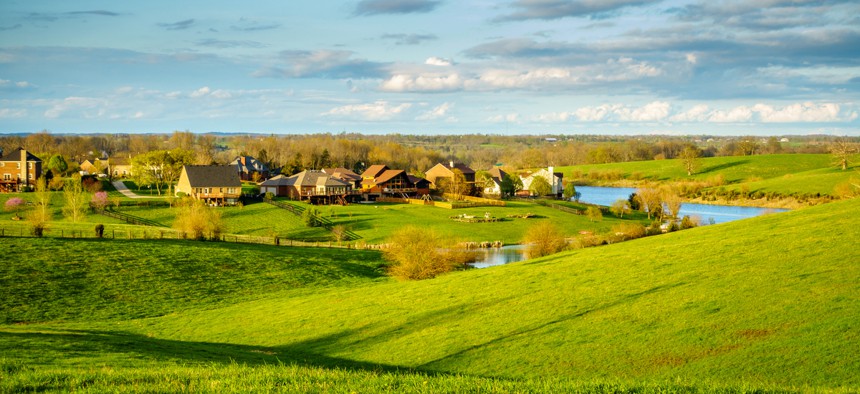Rural Communities Are Finally Getting Attention. So Where Do We Go from Here?

Residential neighborhood in Kentucky's Bluegrass region. SHUTTERSTOCK
COMMENTARY | Despite a recent groundswell of interest, rural America still has unique challenges ahead.
Revitalizing rural America has garnered more attention in the past four years. Despite this renewed interest, reports continue to identify a growing divide between America’s urban centers and rural heartland. The unique challenges and misconceptions facing rural communities continue to hinder economic and educational progress. These obstacles—further exacerbated by the Covid-19 pandemic—raise several questions about the sustainability of rural communities.
Below are several steps organizations and leaders can take to tackle harmful misconceptions about rural America and address the unique challenges that threaten the sustainability of our communities.
1. Recognize that rural communities aren’t a monolith.
While the national media often paints rural communities with broad brushstrokes, the reality is that we’re far more diverse ethnically, culturally and ideologically than believed. The Rural Matters Institute gets it right when they say that to understand rural America, you have to understand one community at a time.
For media organizations, this means that greater partnership between national and local outlets can lead to more nuanced, informed reporting on rural communities, which can in turn help combat harmful misconceptions. For policymakers, it means that sweeping generalizations about rural communities can have damaging consequences and should be avoided.
2. Understand the complex relationship between education and rural workforces.
The labor force behind rural economies, which often depend on mining, agriculture and service industries, is differently skilled than those in urban areas where access to job training is higher and industries are more digitized. Consequently, when employers relocate to rural communities, the skills gap creates serious challenges.
The growing popularity of career and technical education (CTE) in rural states like Kentucky is encouraging, but school districts and local employers must continue thinking outside the box to upskill their local workforces and make rural economies more sustainable. Doing so will likely mean more apprenticeship and work-based learning experiences for students, as well as targeted investments in CTE by state and local governments.
3. Get serious about addressing brain drain.
When large numbers of young, talented college graduates leave their rural hometowns for big cities like Atlanta, Seattle and Nashville, it can pose serious economic concerns for the communities they’ve left behind. This phenomenon, called brain drain, disproportionately impacts rural areas struggling to retain college-educated workers.
Case studies from around the nation have shown that most rural communities are having middling success in addressing brain drain. Tuition breaks, tax incentives, and even free land programs, in which cities and counties give away property to those willing to migrate, have all been employed with mixed results. Data suggests that college graduates with the highest loan balances are the most likely to flock to cities, yet initiatives to help tackle the student debt crisis, like loan forgiveness and expanding community college access, still haven’t been widely adopted. To beat back the effects of rural brain drain, federal, state and local leaders will have to be creative through loan forgiveness initiatives and other bold actions.
4. Expand broadband access.
Expanding broadband connectivity is already a proven game changer for rural communities seeking to retain their young talent, particularly now that more employers are making the work-from-home jump a permanent one. Unfortunately, over 20 million Americans lack adequate access to high-speed internet, and they disproportionately live in rural areas.
While activist groups have been drawing attention to inequitable practices by internet service providers since the onset of the pandemic, rural areas often have their own geographies to blame for their chronic lack of access. Kentucky has put forward an interesting proof of concept in its broadband expansion project KentuckyWired, which, despite early challenges, offers a model for other rural states seeking to expand access. State and federal leaders must step up by investing in broadband expansion, working collaboratively with providers, and making rural communities a priority.
It’s past time we consider the needs of rural communities in the same way we consider the needs of other places. There are no fast or easy answers. But these initial steps offer some concrete ideas for a path forward.
Garris Stroud is a teacher and education advocate from Western Kentucky. He was a semifinalist for Kentucky’s 2020 Teacher of the Year and a former Hope Street Group Kentucky State Teacher Fellow. He serves on the Kentucky Commission of Education's Teacher Advisory Council and writes about public education issues at Kentucky School Talk.
NEXT STORY: State Capitols Reckon With Racism in Policing





